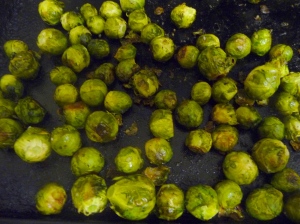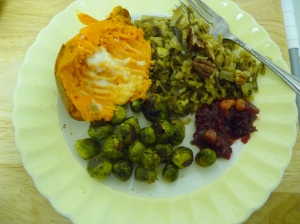
When I returned from Italy with my arm encased in a huge plaster cast, I had a pretty good attitude. But it wasn’t long before I was brought to tears — by an onion.
No, it wasn’t the onion’s irritating juice that was making me cry. It was the reality that without the use of my left hand to hold down the onion, there was no way I could cut it. I had been enjoying other people’s cooking in Italy, but now I wanted to cook for myself and Steve. And without onions — well, what kind of cooking would that be? In my book, onions are as essential as lemons!
Yes, Steve offered to chop the onion, but it was an ordeal. Let’s just say, he is extra sensitive to the onion irritant, and a lot of cursing was involved . Anyway, he was doing so many other tasks (including a total clean-up of the kitchen) that I didn’t want to ask him again.
I don’t know that I ever before fully appreciated the marvel of hands, especially two of them. Or the pleasure of doing even menial tasks for myself — or for someone else.
With a little research, I discovered there are special single-handed cutting boards, which range from simple ones with spikes and corners to hold food down to the fancier Swedish cutting boards with suction feet, more spikes and a vise. These are especially helpful for amputees or stroke victims. But I figured it wouldn’t be worth buying one for my remaining month in a cast.

The purple cast is the latest in a series
Thank goodness my disability is more temporary — and that I also discovered that Trader Joe’s carries bags of chopped onions! Before long, I was sauteeing onions (with celery and carrots that I chopped myself using the cleaned ‘baby-size’ carrots) for minestrone . . . and I only had to ask Steve for help in opening the can of tomatoes.

 I’ve cooked quite a few dishes during this arm-healing period — several batches of minestrone soup, wild mushroom risotto, polenta, spinach-and-feta frittata, oatmeal scones, cornbread, etc. — but it hasn’t all been easy. Over the last 44 days, I’ve had to develop some advice for myself — and then remind myself of it along the way. So here are the basics :
I’ve cooked quite a few dishes during this arm-healing period — several batches of minestrone soup, wild mushroom risotto, polenta, spinach-and-feta frittata, oatmeal scones, cornbread, etc. — but it hasn’t all been easy. Over the last 44 days, I’ve had to develop some advice for myself — and then remind myself of it along the way. So here are the basics :
Be patient– and lower your standards. Plan extra time, because everything will take longer than it used to (or than it does for others). Your frustration will lower in proportion to the extent that you accept this reality. Also, your diminished abilities may mean that you are messier and less precise than you used to be. It helps if you are not a perfectionist.
Adapt when you can — There’s no shame in holding a zipper-lock bag with your teeth so you can open or close it, or clasping a jar in the crook of your damaged arm so you can use your functional hand to open it. Maybe you have to carry jars of water to the heavy cooking pot rather than bringing the pot over to the sink. Maybe you or your friends will come up with creative tools to help with tasks (Steve’s brother Duane had made a wooden holder for the Microplane grater, which I relied on.) A lot of times, there really is an alternative method, even if you don’t get a specialized cutting board.
Stop making yourself crazy. So you can’t do everything. Who can? Adapting can only go so far. My DIY mode had to go. I gave up baking bread in the cast iron Dutch oven (way too heavy) and enjoyed bread from a wonderful local bakery. I tossed out my snooty attitude about buying vegetables in bags (so wasteful and expensive, I’d thought) and gave in to packaged pre-cut butternut squash and triple-washed lettuce in bags (since Steve won’t use the salad spinner.) Also, I decided there was no harm in the occasional frozen food or even (heaven forbid!) using the built-in microwave which I’d formerly relegated to skillet storage.
Ask for help. No matter how independent you are, you will not be able to do everything yourself. If you are lucky, there will be someone around or next door or down the street or even across town who won’t mind helping — and may even be glad you asked.
Still, asking for help — and accepting it graciously — is a lot harder than it seems it should be.
When friends ask, “What can I do to help?” it helps to have something specific in mind — that is, if they really mean it (but do give them an easy out, so you don’t strain the friendship).
For example, when Jennifer asked what I wanted for my birthday, I told her: “A fresh pineapple. If you would cut it for me.” I’d been eyeing the new shipment of pineapples in the store but there was no way I could cut one myself.
 So… lo and behold! — I got exactly what I asked for. And it was one of the best pineapples I ever tasted. Thank you, Jennifer!
So… lo and behold! — I got exactly what I asked for. And it was one of the best pineapples I ever tasted. Thank you, Jennifer!
Allow for mixed emotions —The accident made me contemplate how much I have to be grateful for, from the fact that I didn’t break my right arm or my leg (or both arms, for that matter) to the loving support of Steve and friends. But I wouldn’t be honest if I said it was all gratitude all the time. Every now and then I needed to whine a little about the pain or the disability. I was glad that Steve would (usually) just listen sympathetically without telling me to shape up. Then I could get over it and go on.
 It’s surely a minor problem being a one-handed cook — as Cathy says, remember the big picture — yet I won’t deny that sometimes it’s just a drag. That’s why I’m really looking forward to tomorrow, when the cast comes off!
It’s surely a minor problem being a one-handed cook — as Cathy says, remember the big picture — yet I won’t deny that sometimes it’s just a drag. That’s why I’m really looking forward to tomorrow, when the cast comes off!








 My round challahs are never quite symmetrical, but then, it really doesn’t matter!
My round challahs are never quite symmetrical, but then, it really doesn’t matter!
 THE TROUBLE BEGAN HERE: an attractive photo in a cooking magazine for “pumpkin caramel tart with toasted hazelnut crust.” It was just before Thanksgiving, when I was considering what I could bring for dessert — and it was tempting.
THE TROUBLE BEGAN HERE: an attractive photo in a cooking magazine for “pumpkin caramel tart with toasted hazelnut crust.” It was just before Thanksgiving, when I was considering what I could bring for dessert — and it was tempting.




























